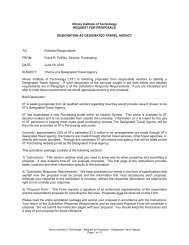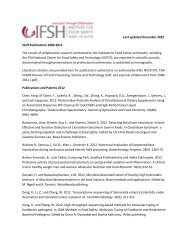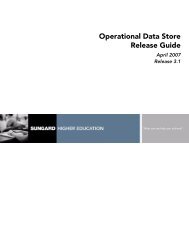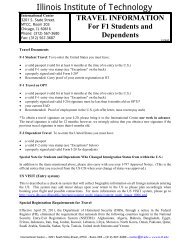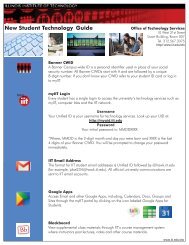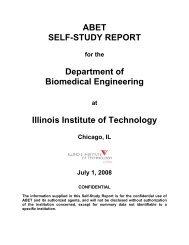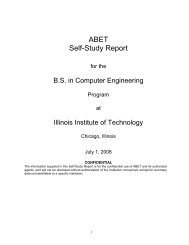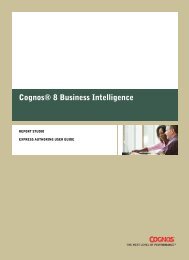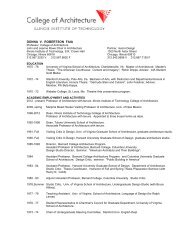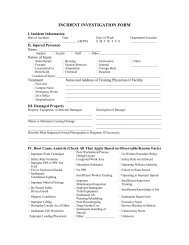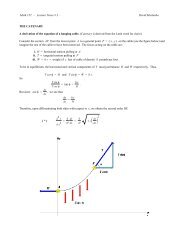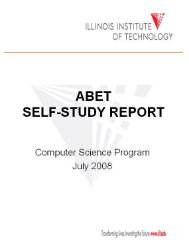Copyright & Disclaimer Information - Illinois Institute of Technology
Copyright & Disclaimer Information - Illinois Institute of Technology
Copyright & Disclaimer Information - Illinois Institute of Technology
You also want an ePaper? Increase the reach of your titles
YUMPU automatically turns print PDFs into web optimized ePapers that Google loves.
MATH 482<br />
Introduction to Markov Processes<br />
Random walks, discrete time Markov<br />
chains; Poisson processes, continuous<br />
time Markov chains; renewal theory.<br />
Prerequisite: MATH 475. (3-0-3)<br />
MATH 483<br />
Design and Analysis <strong>of</strong> Experiments<br />
Principles <strong>of</strong> estimation; hypothesis<br />
tests, confidence intervals. Contingency<br />
tables; goodness-<strong>of</strong>-fit. Analysis <strong>of</strong> variance;<br />
linear regression. Hierarchical and<br />
split-plot designs; analysis <strong>of</strong> covariance.<br />
Multiple regression. Prerequisite:<br />
MATH 476. (3-0-3)<br />
MATH 485<br />
Introduction to Mathematical Finance<br />
This is an introductory course in<br />
mathematical finance. Technical difficulty<br />
<strong>of</strong> the subject is kept at a minimum<br />
by considering a discrete time<br />
framework. Nevertheless, the major<br />
ideas and concepts underlying modern<br />
mathematical finance and financial<br />
engineering will be explained<br />
and illustrated. Credit may not be<br />
granted for MATH 485 and MATH<br />
548. Prerequisite: MATH 475 or<br />
equivalent. (3-0-3)<br />
MATH 486<br />
Mathematical Modeling I<br />
A general introduction to optimization<br />
problems. Linear programming: the<br />
simplex method. Elements <strong>of</strong> graphs<br />
and networks. Introduction to game<br />
theory. Applications. Prerequisite:<br />
MATH 475 or consent <strong>of</strong> instructor.<br />
(3-0-3) (C)<br />
MATH 487<br />
Mathematical Modeling II<br />
The formulation <strong>of</strong> mathematical<br />
models, solution <strong>of</strong> mathematical<br />
equations, and interpretation <strong>of</strong><br />
results. Selected topics from queueing<br />
theory and financial derivatives.<br />
Prerequisite: MATH 252. (3-0-3) (C)<br />
MATH 488<br />
Ordinary Differential Equations and Dynamical<br />
Systems<br />
Boundary-value problems and<br />
Sturm-Liouville theory; linear system<br />
theory via eigenvalues and<br />
eigenvectors; Floquet theory; nonlinear<br />
systems: critical points, linearization,<br />
stability concepts, index theory,<br />
<strong>Copyright</strong> & <strong>Disclaimer</strong> <strong>Information</strong>: <strong>Copyright</strong> © 1994, 1995, 1996, 1997, 1998, 1999, 2000, 2001, 2002, 2003, 2004, 2005, 2006, 2007. CollegeSource®, Inc. and Career Guidance Foundation. CollegeSource® digital catalogs are derivative works owned and copyrighted by CollegeSource®, Inc. and Career Guidance Foundation. Catalog content is owned and copyrighted by the appropriate school. While CollegeSource®, Inc. and Career Guidance Foundation provides information as a service to the public, copyright is retained on all digital catalogs.<br />
<strong>Copyright</strong> & <strong>Disclaimer</strong> <strong>Information</strong>: <strong>Copyright</strong> © 1994, 1995, 1996, 1997, 1998, 1999, 2000, 2001, 2002, 2003, 2004, 2005, 2006, 2007. CollegeSource®, Inc. and Career Guidance Foundation. CollegeSource® digital catalogs are derivative works owned and copyrighted by CollegeSource®, Inc. and Career Guidance Foundation. Catalog content is owned and copyrighted by the appropriate school. While CollegeSource®, Inc. and Career Guidance Foundation provides information as a service to the public, copyright is retained on all digital catalogs.<br />
phase portrait analysis, limit cycles,<br />
and stable and unstable manifolds;<br />
bifurcation; and chaotic dynamics.<br />
Prerequisites: MATH 251, MATH 252.<br />
(3-0-3)<br />
MATH 489<br />
Partial Differential Equations<br />
First-order equations, characteristics.<br />
Classification <strong>of</strong> second-order equations.<br />
Laplace’s equation: potential<br />
theory, Green’s function, maximum<br />
principles. The wave equation: characteristics,<br />
general solution. The heat<br />
equation: use <strong>of</strong> integral transforms.<br />
Prerequisite: MATH 461. (3-0-3)<br />
MATH 491<br />
Reading and Research<br />
(Credit: Variable) (C)<br />
Military Science<br />
MILS 101<br />
Foundations <strong>of</strong> Officership<br />
Issues and competencies that are<br />
central to a commissioned <strong>of</strong>ficer’s<br />
responsibilities. Establish framework<br />
for understanding <strong>of</strong>ficership, leadership,<br />
and Army values followed and<br />
“life skills” such as physical fitness<br />
and time management. (1-2-1) (C)<br />
MILS 102<br />
Basic Leadership<br />
Establishes foundation <strong>of</strong> basic leadership<br />
fundamentals such as problem<br />
solving, communications, briefings<br />
and effective writing, goal setting<br />
techniques for improving listening<br />
and speaking skills, and an introduction<br />
to counseling. (1-2-1) (C)<br />
MILS 107<br />
American Military History<br />
Study <strong>of</strong> American military history<br />
through examination <strong>of</strong> evolvement <strong>of</strong><br />
the Army and warfare. (3-2-3)<br />
MILS 147, 148, 247, 248, 347, 348, 447, 448<br />
Aerobic Conditioning<br />
Participation in aerobic exercise program;<br />
evaluation <strong>of</strong> the level <strong>of</strong> cardiovascular<br />
fitness. (0-3-2)<br />
MILS 201<br />
Individual Leadership Studies<br />
Students identify successful leadership<br />
characteristics through observa-<br />
IIT Undergraduate Bulletin 2006–2008<br />
Course Descriptions<br />
tion <strong>of</strong> others and self and through<br />
experiential learning exercises.<br />
Students record observed traits (good<br />
and bad) in a dimensional leadership<br />
journal and discuss observations in<br />
small group settings. (2-2-2)<br />
MILS 202<br />
Leadership and Teamwork<br />
Study examines how to build successful<br />
teams, various methods for<br />
influencing action, effective communication<br />
in setting and achieving<br />
goals, the importance <strong>of</strong> timing the<br />
decision, creativity in the problem<br />
solving process, and obtaining team<br />
buy-in through immediate feedback.<br />
(2-2-2)<br />
MILS 301<br />
Leadership and Problem Solving<br />
Students conduct self-assessment <strong>of</strong><br />
leadership style, develop personal fitness<br />
regimen, and learn to plan and<br />
conduct individual/ small unit tactical<br />
training while testing reason and<br />
problem-solving techniques. Students<br />
receive direct feedback on leadership<br />
abilities. Prerequisites: Basic course<br />
or equivalent and consent <strong>of</strong> the<br />
department. (3-2-3) (C)<br />
MILS 302<br />
Leadership and Ethics<br />
Examines the role communications,<br />
values, and ethics play in effective<br />
leadership. Topics include ethical<br />
decision-making, consideration <strong>of</strong><br />
others, spirituality in the military,<br />
and survey Army leadership doctrine.<br />
Emphasis on improving oral and<br />
written communication abilities.<br />
Prerequisites: MILS 301 and consent<br />
<strong>of</strong> the instructor. (3-2-3) (C)<br />
MILS 401<br />
Leadership and Management<br />
Develops student pr<strong>of</strong>iciency in planning<br />
and executing complex operations,<br />
functioning as a member <strong>of</strong> a<br />
staff, and mentoring subordinates.<br />
Students explore training management,<br />
methods <strong>of</strong> effective staff collaboration,<br />
and developmental counseling<br />
techniques. Prerequisites:<br />
MILS 301, 302 and consent <strong>of</strong> the<br />
instructor. (3-2-3) (C)<br />
195



